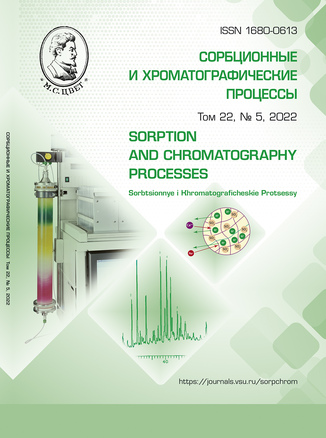Composite aerogels based on reduced graphene oxide decorated with iron oxide nanoparticles for the sorption of heavy and rare earth metals from solutions of complex compositions
Abstract
The study is devoted to the development of a promising technology for obtaining effective sorption materials based on modified graphene structures using available and environmentally friendly reagents. Iron (III) chloride was used as feedstock for the production of iron oxide nanoparticles. By mixing solutions of iron acetate with a dispersion of graphene oxide with further reduction of iron hydroxides to oxides and graphene oxide to graphene with ascorbic acid, a stable hydrogel structure was obtained. Using drying methods in supercritical isopropanol, a highly porous aerogel modified with iron oxide nanoparticles was synthesized. The resulting composite material was characterized by SEM, TEM, XRD, and BET methods. It has been established that iron nanoparticles are present in the aerogel structure in the form of ferromagnetic oxide phases – γ-Fe2O3 and Fe3O4. The TEM method showed that the particles are uniformly distributed in the carbon matrix of the aerogel; the average size of the identified iron oxide nanoparticles did not exceed 100 nm. The XRD method confirmed the reduction of graphene oxide during synthesis, as well as the presence of iron oxides in the aerogel structure in the proposed ferromagnetic forms. It has been established by nitrogen adsorption/desorption method that the structure of the aerogel is represented mainly by micropores. The specific surface area of the synthesized aerogel was 670 m2/g. The possibility for the efficient complex extraction of rare earth elements by the synthesized aerogel was shown for the adsorption of a wide range of metal ions from weakly acidic solutions of complex composition. The total degree of extraction exceeded 80%, and for some actinides - 95%, while the total degree of extraction of alkaline earth elements was about 10%.
Downloads
References
Zamora-Ledezma C., Negrete-Bolagay D., Figueroa F., Zamora-Ledezma E., Ni M., Alexis F., Guerrero V.H. Heavy metal water pollution: A fresh look about hazards, novel and conventional remediation methods. Environmental Technology & Innovation. 2021; 22: 101504. https://doi.org/10.1016/j.eti.2021.101504
Bolisetty S., Peydayesh M., Mezzenga R. Sustainable technologies for water purification from heavy metals: review and analysis. Chemical Society Reviews. 2019; 48: 463-487. https://doi.org/10.1039/C8CS00493E
Neskoromnaya E.A., Khamizov R.K., Melezhyk A.V., Memetova A.E., Mkrtchan E.S., Babkin A.V. Adsorption of lead ions (Pb2+) from wastewater using effective nanocomposite GO/CMC/FeNPs: Kinetic, isotherm, and desorption studies. Colloids and Surfaces A: Physicochemical and Engineering Aspects. 2022; 655: 130224. https://doi.org/10.1016/j.colsurfa.2022.130224
Ali I., Neskoromnaya E.A., Melezhik A.V. et al. Magnetically active nanocomposite aerogels: preparation, characterization and application for water treatment. J Porous Mater. 2022; 29: 545-557. https://doi.org/10.1007/s10934-021-01175-0
Liu X., Ma R., Wang X., Ma Ya., Yang Yo., Zhuang L., Zhang S., Jehan R., Chen J., Wang X. Graphene oxide-based materials for efficient removal of heavy metal ions from aqueous solution: A review. Environmental Pollution. 2019: 252(A): 62-73. https://doi.org/10.1016/j.envpol.2019.05.050
Zhan W., Gao L., Fu X., Siyal S.H., Sui G., Yang X. Green synthesis of amino-functionalized carbon nanotube-graphene hybrid aerogels for high performance heavy metal ions removal. Applied Surface Science. 2019; 467-46: 1122-1133. https://doi.org/10.1016/j.apsusc.2018.10.248
Memetova A.E., Neskromnaya E.A., Zelenin А.D., Babkin A.V., Memetov N.R., Gerasimova А.V. Methane adsorption on graphene aerogel. Sorbtsionnye i khromatograficheskie protsessy. 2022. 22(1): 41-49. (In Russ.). https://doi.org/10.17308/sorpchrom.2022.22/9019
Quan L.D., Dang N.H., Tu T.H., Linh V.N.Ph., Thy Lu Thi Mong, Nam H.M., Phong M.T., Hieu N.H. Preparation of magnetic iron oxide/graphene aerogel nanocomposites for removal of bisphenol A from water. Synthetic Metals. 2019; 255: 116106. https://doi.org/10.1016/j.synthmet.2019.116106
Neskoromnaya E.A., Burakov A.E., Melezhik A.V. et al. Synthesis and Evaluation of Adsorption Properties of Reduced Graphene Oxide Hydro- and Aerogels Modified by Iron Oxide Nanoparticles. Inorg. Mater. Appl. Res. 2020; 11: 467-475. https://doi.org/10.1134/S2075113320020264
Trinh Thi T.Phuong Nguyet Xuan, Quang D.T., Tu, T.H. Nguyen Minh Dat, Linh Vu Ngoc Phuong, Cuong Le Van, Nghia Le Tran Trung, Loan Tran Thi, Hang Pham Thuy, Phuong Nguyen Thi Lien, Phong Mai Thanh, Nam Hoang Minh, Hieu Nguyen Huu Fabrication, characterization, and adsorption capacity for cadmium ions of graphene aerogels. Synthetic Metals. 2019; 247: 116-123. https://doi.org/10.1016/j.synthmet.2018.11.020
Huang Z.G., Guo Z.P., Calka A., Wexler D., Lukey C., Liu H.K. Effects of iron oxide (Fe2O3, Fe3O4) on hydrogen storage properties of Mg-based composites. Journal of Alloys and Compounds. 2006; 422(1-2); 299-304. https://doi.org/10.1016/j.jallcom.2005.11.074
Jeyavenkatesh M., Arunodaya J., Sahoo T. One Pot Polyol Synthesis of Fe2O3-Fe3O4 Nano Composites and Their Structural, Optical, Property Studies. IOP Conference Series: Materials Science and Engineering. IOP Publishing, 2022; 1219(1): 012043.
Prawit Nuengmatcha, Paweena Porrawatkul, Saksit Chanthai, Phitchan Sricharoen, Nunticha Limchoowong. Enhanced photocatalytic degradation of methylene blue using Fe2O3/graphene/CuO nanocomposites under visible light. Journal of Environmental Chemical Engineering. 2019; 7(6): 103438. https://doi.org/10.1016/j.jece.2019.103438







